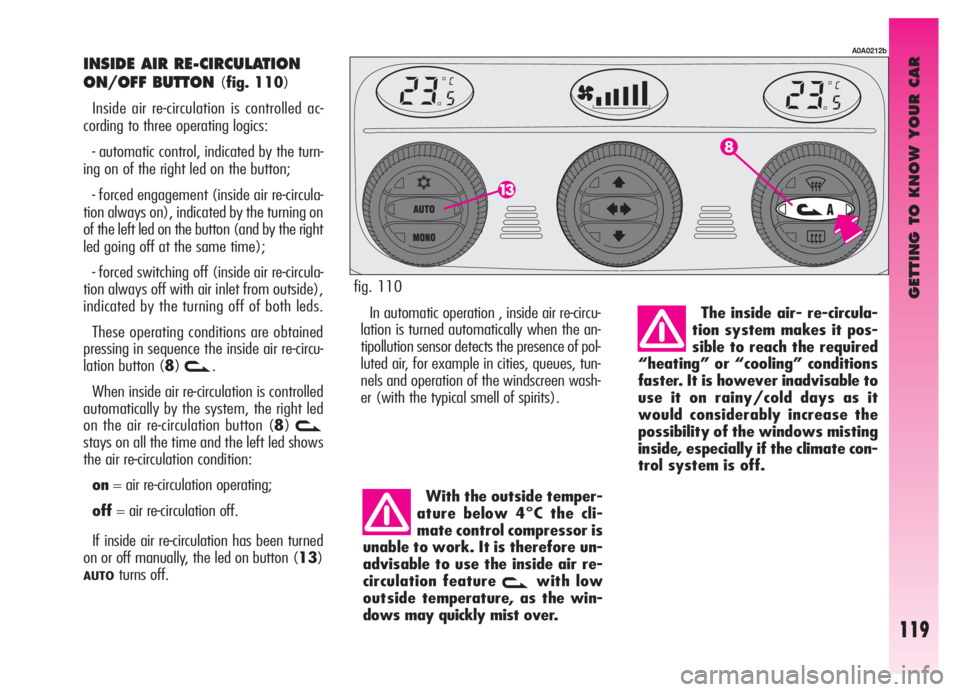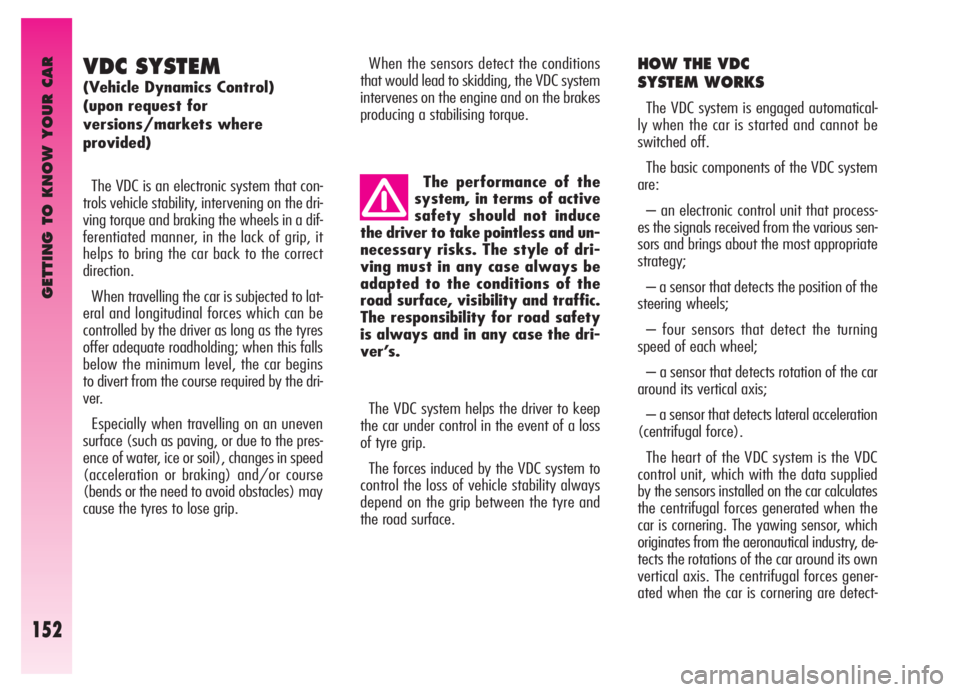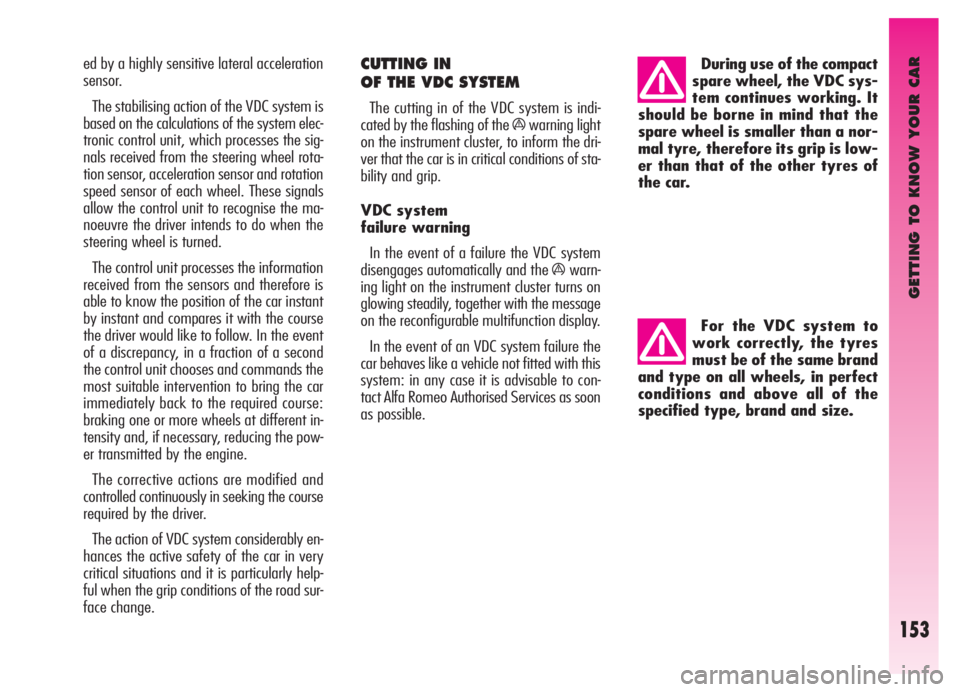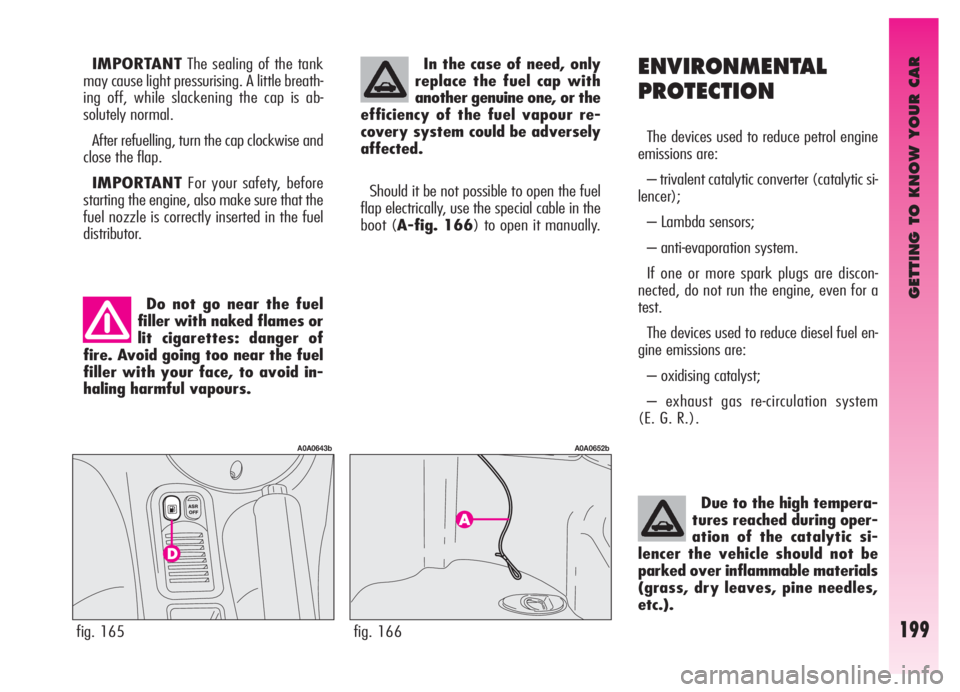sensor Alfa Romeo GT 2005 Owner handbook (in English)
[x] Cancel search | Manufacturer: ALFA ROMEO, Model Year: 2005, Model line: GT, Model: Alfa Romeo GT 2005Pages: 307, PDF Size: 6.05 MB
Page 121 of 307

GETTING TO KNOW YOUR CAR
119
INSIDE AIR RE-CIRCULATION
ON/OFF BUTTON
(fig. 110)
Inside air re-circulation is controlled ac-
cording to three operating logics:
- automatic control, indicated by the turn-
ing on of the right led on the button;
- forced engagement (inside air re-circula-
tion always on), indicated by the turning on
of the left led on the button (and by the right
led going off at the same time);
- forced switching off (inside air re-circula-
tion always off with air inlet from outside),
indicated by the turning off of both leds.
These operating conditions are obtained
pressing in sequence the inside air re-circu-
lation button (8)
v.
When inside air re-circulation is controlled
automatically by the system, the right led
on the air re-circulation button (8)
v
stays on all the time and the left led shows
the air re-circulation condition:
on= air re-circulation operating;
off= air re-circulation off.
If inside air re-circulation has been turned
on or off manually, the led on button (13)
AUTOturns off.In automatic operation , inside air re-circu-
lation is turned automatically when the an-
tipollution sensor detects the presence of pol-
luted air, for example in cities, queues, tun-
nels and operation of the windscreen wash-
er (with the typical smell of spirits).The inside air- re-circula-
tion system makes it pos-
sible to reach the required
“heating” or “cooling” conditions
faster. It is however inadvisable to
use it on rainy/cold days as it
would considerably increase the
possibility of the windows misting
inside, especially if the climate con-
trol system is off.
A0A0212b
With the outside temper-
ature below 4°C the cli-
mate control compressor is
unable to work. It is therefore un-
advisable to use the inside air re-
circulation feature
vwith low
outsidetemperature, as the win-
dows may quickly mist over.
fig. 110
Page 125 of 307

Rear sensors are auto-
matically switched off
when the trailer’s electric
cable plug is inserted into the car
tow hitch socket.
Rear sensors are automatically switched
on by removing the trailer cable plug.
GETTING TO KNOW YOUR CAR
123
PARKING SENSORS
(fig. 113a)
(optional for versions/markets where
applicable)
The parking system detects and informs
the driver (through an intermittent acoustic
signal) about the presence of obstacles in
the rear part of the car.
ACTIVATION
The sensors are automatically activated
when the reverse gear is engaged.
The sound produced by the acoustic alarm
becomes continuous when the distance be-
tween the car and the obstacle is less that
30 cm.
ACOUSTIC SIGNAL
When the reverse gear is engaged an in-
termittent acoustic signal is automatically
activated.
The acoustic signal:
– raises with the reduction of distance be-
tween the car and the obstacle;
– becomes continuous when the distance
between the car and the obstacle is less that
30 cm and stops if the distance raises.
– is constant if the distance is unvaried.
If this situation takes place for side sensors,
the signal is stopped after about 3 seconds
to prevent sound indications when per-
forming manoeuvres near walls.
TOWING A TRAILER
fig. 113a
A0A0735b
Page 147 of 307

GETTING TO KNOW YOUR CAR
145
OPENING FROM INSIDE
(fig. 143)
Tailgate is released electrically and this can
be performed only when the ignition key
is in position MARwith car at a standstill
or in STOPorPARKposition for 3 min-
utes without unlocking/locking one of the
doors.
To unlock the tailgate, press button (A)
on the centre console panel.
Tailgate raising is facilitated by the gas
shock springs.
OPENING WITH REMOTE
CONTROL
(fig. 144)
The tailgate can be opened by remote con-
trol from outside pressing the button (A),
also when the electronic alarm is engaged.
Opening of the tailgate is accompanied by
a double flash of the direction indicators;
closing is accompanied by a single flash.
If an electronic alarm is fitted, with the
opening of the tailgate, the alarm system
switches off volumetric protection and the
tailgate control sensor, the system “beeps”
twice (with the exception of certain mar-
kets).
Closing the tailgate again, the control func-
tions are restored, the system “beeps” twice
(with the exception of certain markets).
fig. 143
A0A0129b
LUGGAGE
COMPARTMENT
The tailgate can be opened:
from the outside of the car- by a
remote control impulse;
from the inside of the door- by de-
pressing the button (A-fig. 143).
IMPORTANTIf the boot is not proper-
ly shut, the
´warning light will come on
(on certain versions accompanied by the
message on the reconfigurable multifunction
display).
The gas springs are cali-
brated to ensure correct
tailgate raising with the
weights foreseen by the manufac-
turer. The arbitrary addition of
items (such spoilers, etc.) may
compromise the correct operation
and safety of the actual tailgate.
fig. 144
A0A0636b
Page 153 of 307

GETTING TO KNOW YOUR CAR
151
Always take due care when braking on
bends, even with the help of the ABS.
The most important advice of all, howev-
er, is this:
When the ABS cuts in, and
you feel the pulsing on the
pedal, do not lighten the
pressure, but keep the pedal firm-
ly pressed with no fear; this way
you will stop in the least space
possible, compatibly with the con-
ditions of the road surface.
Following these instructions you will be
in the best braking condition under all cir-
cumstances.
IMPORTANTCars fitted with ABS may
only be fitted with the wheel rims, tyres and
brake linings of type and brand approved by
the Manufacturer.
The system is completed by the EBD (Elec-
tronic Brake Distributor) which distributes
the braking action through the control unit
and the ABS system sensors.The car is fitted with an
electronic braking distribu-
tor (EBD). If the
>andx
warning lights turn on simultane-
ously with the engine running, this
indicates an EBD system failure; in
this case with sharp braking the
rear wheels might lock too early,
with the possibility of skidding.
Driving extremely carefully, go to
the nearest Alfa Romeo Authorised
Service to have the system
checked.
The turning on of only the
>warning light with the
engine running normally in-
dicates a fault to the ABS system
only. In this case the braking sys-
tem is still efficient, though with-
out the aid of the anti-lock device.
Under these conditions perfor-
mance of the EBD system may be
reduced. In this case too, you are
advised to go immediately to the
nearest Alfa Romeo Authorised
Service to have the system checked
over, driving in such a way as to
avoid sharp braking.
If the low brake fluid lev-
el
xwarning light turns
on, stop the car immedi-
ately and contact the nearest Alfa
Romeo Authorised Service. Any
loss of fluid from the hydraulic sys-
tem will negatively affect the op-
eration of the braking system be it
of the conventional type or of the
type with ABS.
If the compact spare wheel
is used, operation of the
ABS system is cut off and
the
>warning light on the instru-
ment cluster turns on.
IMPORTANTIf the battery is run down
the
>andxwarning lights might turn
on when starting the engine and go off af-
ter starting. This should not be considered
as a fault but as a warning that during start-
ing the ABS is not active. The turning off
of the warning lights ensures normal system
operation.
Page 154 of 307

GETTING TO KNOW YOUR CAR
152
VDC SYSTEM
(Vehicle Dynamics Control)
(upon request for
versions/markets where
provided)
The VDC is an electronic system that con-
trols vehicle stability, intervening on the dri-
ving torque and braking the wheels in a dif-
ferentiated manner, in the lack of grip, it
helps to bring the car back to the correct
direction.
When travelling the car is subjected to lat-
eral and longitudinal forces which can be
controlled by the driver as long as the tyres
offer adequate roadholding; when this falls
below the minimum level, the car begins
to divert from the course required by the dri-
ver.
Especially when travelling on an uneven
surface (such as paving, or due to the pres-
ence of water, ice or soil), changes in speed
(acceleration or braking) and/or course
(bends or the need to avoid obstacles) may
cause the tyres to lose grip.When the sensors detect the conditions
that would lead to skidding, the VDC system
intervenes on the engine and on the brakes
producing a stabilising torque.
HOW THE VDC
SYSTEM WORKS
The VDC system is engaged automatical-
ly when the car is started and cannot be
switched off.
The basic components of the VDC system
are:
– an electronic control unit that process-
es the signals received from the various sen-
sors and brings about the most appropriate
strategy;
– a sensor that detects the position of the
steering wheels;
– four sensors that detect the turning
speed of each wheel;
– a sensor that detects rotation of the car
around its vertical axis;
– a sensor that detects lateral acceleration
(centrifugal force).
The heart of the VDC system is the VDC
control unit, which with the data supplied
by the sensors installed on the car calculates
the centrifugal forces generated when the
car is cornering. The yawing sensor, which
originates from the aeronautical industry, de-
tects the rotations of the car around its own
vertical axis. The centrifugal forces gener-
ated when the car is cornering are detect- The performance of the
system, in terms of active
safety should not induce
the driver to take pointless and un-
necessary risks. The style of dri-
ving must in any case always be
adapted to the conditions of the
road surface, visibility and traffic.
The responsibility for road safety
is always and in any case the dri-
ver’s.
The VDC system helps the driver to keep
the car under control in the event of a loss
of tyre grip.
The forces induced by the VDC system to
control the loss of vehicle stability always
depend on the grip between the tyre and
the road surface.
Page 155 of 307

GETTING TO KNOW YOUR CAR
153
ed by a highly sensitive lateral acceleration
sensor.
The stabilising action of the VDC system is
based on the calculations of the system elec-
tronic control unit, which processes the sig-
nals received from the steering wheel rota-
tion sensor, acceleration sensor and rotation
speed sensor of each wheel. These signals
allow the control unit to recognise the ma-
noeuvre the driver intends to do when the
steering wheel is turned.
The control unit processes the information
received from the sensors and therefore is
able to know the position of the car instant
by instant and compares it with the course
the driver would like to follow. In the event
of a discrepancy, in a fraction of a second
the control unit chooses and commands the
most suitable intervention to bring the car
immediately back to the required course:
braking one or more wheels at different in-
tensity and, if necessary, reducing the pow-
er transmitted by the engine.
The corrective actions are modified and
controlled continuously in seeking the course
required by the driver.
The action of VDC system considerably en-
hances the active safety of the car in very
critical situations and it is particularly help-
ful when the grip conditions of the road sur-
face change.For the VDC system to
work correctly, the tyres
must be of the same brand
and type on all wheels, in perfect
conditions and above all of the
specified type, brand and size.CUTTING IN
OF THE VDC SYSTEM
The cutting in of the VDC system is indi-
cated by the flashing of the
áwarning light
on the instrument cluster, to inform the dri-
ver that the car is in critical conditions of sta-
bility and grip.
VDC system
failure warning
In the event of a failure the VDC system
disengages automatically and the
áwarn-
ing light on the instrument cluster turns on
glowing steadily, together with the message
on the reconfigurable multifunction display.
In the event of an VDC system failure the
car behaves like a vehicle not fitted with this
system: in any case it is advisable to con-
tact Alfa Romeo Authorised Services as soon
as possible.During use of the compact
spare wheel, the VDC sys-
tem continues working. It
should be borne in mind that the
spare wheel is smaller than a nor-
mal tyre, therefore its grip is low-
er than that of the other tyres of
the car.
Page 201 of 307

GETTING TO KNOW YOUR CAR
199
ENVIRONMENTAL
PROTECTION
The devices used to reduce petrol engine
emissions are:
– trivalent catalytic converter (catalytic si-
lencer);
– Lambda sensors;
– anti-evaporation system.
If one or more spark plugs are discon-
nected, do not run the engine, even for a
test.
The devices used to reduce diesel fuel en-
gine emissions are:
– oxidising catalyst;
– exhaust gas re-circulation system
(E. G. R.). Do not go near the fuel
filler with naked flames or
lit cigarettes: danger of
fire. Avoid going too near the fuel
filler with your face, to avoid in-
haling harmful vapours.
In the case of need, only
replace the fuel cap with
another genuine one, or the
efficiency of the fuel vapour re-
covery system could be adversely
affected.
Should it be not possible to open the fuel
flap electrically, use the special cable in the
boot (A-fig. 166) to open it manually.
Due to the high tempera-
tures reached during oper-
ation of the catalytic si-
lencer the vehicle should not be
parked over inflammable materials
(grass, dry leaves, pine needles,
etc.).
fig. 165
A0A0643b
fig. 166
A0A0652b
IMPORTANTThe sealing of the tank
may cause light pressurising. A little breath-
ing off, while slackening the cap is ab-
solutely normal.
After refuelling, turn the cap clockwise and
close the flap.
IMPORTANTFor your safety, before
starting the engine, also make sure that the
fuel nozzle is correctly inserted in the fuel
distributor.
Page 243 of 307

IN AN EMERGENCY
241
Volumetric sensors
ESP system sensor
Steering angle sensor
EOBD system diagnosis socket
Cell phone provision
Driver’s door control unit supply
Passenger’s door control unit supply
Control lighting
Climate control system control lighting
Instrument cluster
Instrument cluster
Driver’s door control unit
ABS control unit
ABS control unit
Dashboard control unit
Air - bag control unit
Electronic injection control unit +30
Engine compartment control box (petrol versions)
Dashboard control unit
Trailer control unit15
7.5
7.5
15
15
20
20
7.5
7.5
10
10
15
7.5
50
50
7.5
7.5
125
70
10 F39
F42
F42
F39
F39
F47
F48
F49
F35
F37
F53
F39
F42
F04 (MAXI-FUSE)
F02 (MAXI-FUSE)
F50
F18
F70 (MEGA-FUSE)
F71 (MAXI-FUSE)
F36 52
52
52
52
52
52
52
52
52
52
52
52
52
53
53
52
53
54
54
52
SERVICES FIGURE FUSE AMPERES
Page 262 of 307

VEHICLE MAINTENANCE
260
DIESEL FUEL FILTER
(JTD16Vversions)
DRAINING CONDENSATION
WATER
The presence of water in
the supply circuit may
cause serious damage to
the entire injection system and
cause irregular running of the
engine. If the
cwarning light
turns on together with the mes-
sage on the reconfigurable multi-
function display, contact Alfa
Romeo Authorised Services as
soon as possible to have the sys-
tem relieved.
AIR CLEANER
The air cleaner is connected to the tem-
perature and air flow sensors which send
to the control unit the electric signals
needed for correct operation of the injec-
tion and ignition system.
It must therefore always be in perfect
conditions, to ensure correct operation of
the engine, low consumption and exhaust
emission levels.
If the operations con-
cerning cleaner replace-
ment described below are
not carried out correctly and with
the due precautions, they may
compromise the travelling safety
of the vehicle. You are recom-
mended to have this operation
carried out by Alfa Romeo
Authorised Services.
If the car is habitually
used in dusty areas, the
cleaner should be replaced
at shorter intervals than those
specified in the Programmed
Maintenance Schedule.
Any attempt to clean the
cleaner may damage it,
leading to serious engine
damage.
Page 290 of 307

RIGHT HAND DRIVE VERSIONS
288
fig. 6
A0A0724b
RIGHT HAND DRIVE VERSIONS - DASHBOARD
1.Side swivel air vents - 2.Fixed side window air vents -3.Passenger's air bag - 4.Tailgate release button - 5.Card holder (for versions/markets where
applicable) - 6. Sound system (for versions/markets where applicable) - 7.Centre swivel air vents - 8.Fixed upper vent - 9.Glass holder (for versions/mar-
kets where applicable) - 10.Front fog light button - 11.Hazard light switch - 12.Rear fog light button - 13.Outside light control lever - 14.Speedome-
ter with display for mileage recorder, trip meter and headlamp aiming device - 15.Fuel level gauge with reserve warning light - 16.Multifunction display -
17.Engine coolant temperature gauge - 18.Rev. counter -19.Windscreen wiper control lever - 20.Bonnet opening lever - 21.Set of controls: trip meter
reset, headlamp aiming device, trip computer - 22.Ignition key and switch - 23.Horn - 24.Steering wheel locking/release lever - 25.Driver's air bag -
26.Door locking button - 27.Controls for heating, ventilation and climate control - 28.Cigar lighter/ashtray housing door - 29.Temperature sensor - 30.
Glove box.